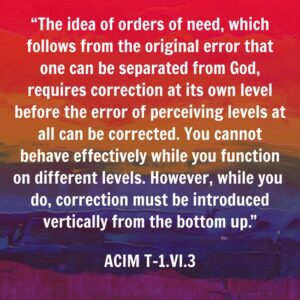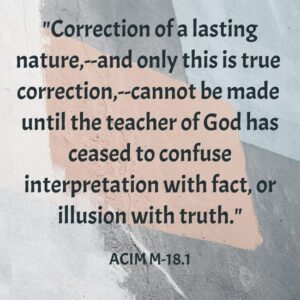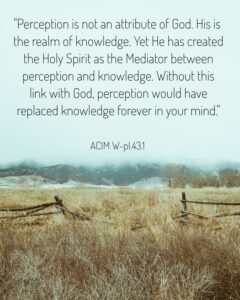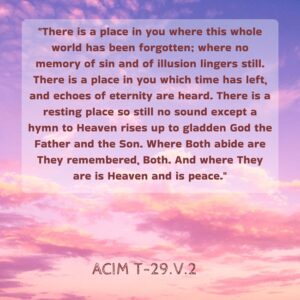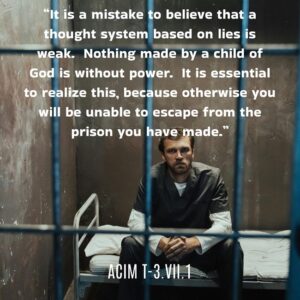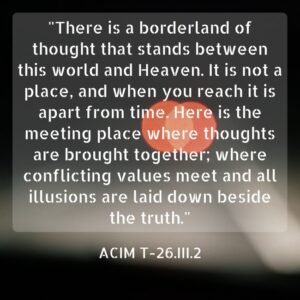
ACIM and Life After Death
A Course in Miracles is mysteriously silent on our state after death, which would be our state of existence between lives. It mentions death in some context over 500 times, but instead of dealing with life after the death of the body it places great emphasis in dealing with our life in the body, and the fear of death in relation to it.
A student may legitimately wonder why almost all the discussion on death is related to this side of the veil. After much thought, I have concluded that the emphasis is on this world because this is where the awakening must happen:
“The world is not left by death but by truth, and truth can be known by all those for whom the Kingdom was created, and for whom it waits.” T-3.VII.6
So, the solution to the separation is not found by dying, but in finding and living the truth while in the world.
The Course tells us that the separation “occurred over millions of years” T-2.VIII.2 During this time it is assumed we have lived many lifetimes. We most likely spent more time out of a body rather than in a body. The question then arises as to where and what is this “undiscovered country” we go to after vacating the body? Why does not the Course say anything about it?
Perhaps it does. I have found that the Course says much more than it seems on a casual reading, and the realm we go to after we leave the body is no exception.
We are given this interesting hint:
“To be without a body is to be in our natural state.” W-pI.72.9
Yes, the Course advises us to overlook the body, but where are when we in a state where we are actually “without a body”?
That would be that period we spend in between lives where we have no physical body. If we then accept what the Course actually says we are led to believe that our state of existence after the death of the body is “our natural state.”
So, what is meant by our natural state? We are told this:
“By demonstrating to yourself there is no order of difficulty in miracles, you will convince yourself that, in your natural state, there is no difficulty at all because it is a state of grace. Grace is the natural state of every Son of God. When he is not in a state of grace, he is out of his natural environment and does not function well.” T-7.XI.1-2
Indeed, we have many limitations while out of our natural state and seeing ourselves in the body.
Also, the natural state is communion beyond perception for “Perception is based on a separated state, so that anyone who perceives at all needs healing. Communion, not prayer, is the natural state of those who know.” T-3.V.10
The Course says that the body “limits your ability to make communion with your brother’s mind.” T-29.I.5. This verifies that without the body we will be in a natural state where pure communication and the miraculous state of grace are normal.
If we then spend most of our separated existence in the natural state between lives with no body why then would the Course be silent on it?
I submit that it is not, but actually makes many references to this state.
Instead of calling the after-death state something with which we are familiar, like “the spirit world,” it calls it “the real world”.
“Hold on,” says the doubter. “The real world is something we achieve in this world and shortly thereafter God takes us from there into heaven.”
Yes, this is true for “the world is not left by death” T-3.VII.6 But after we leave the body, we actually enter the natural state or the “real world, in which everything reflects the eternal.” T-12.III.8
In other words, the goal here, while in the body, is to achieve that natural state we have after the death of the body.
A reasonable response of the reader at this point may be something like this: “You make an interesting proposal, but can you give us any evidence that the after-death experience takes place in the real world?”
That is a reasonable question. To answer it let us look at the ACIM’s descriptions of the real world and compare them to the after-death description of existence there.
“What are you talking about?” says the skeptic. “We have no descriptions of the life after the death of the body.”
But we do my friend. There are many thousands who have had a near death experience and have given us descriptions of life without the limitations of the body. There are common elements in these experiences that correspond to the Course’s description of the real world.
In addition, there have been thousands of regressions by trained therapists who have retrieved memories of life between lives. That which the subjects retrieved are very consistent with each other as well as those who had the near-death experience.
So let us see what the Course says about the real world and compare it to what these people who recall visiting the world of Spirit say and see how they compare.
NDEs and the Real World
Let us look at the similarities between descriptions of the afterworld by those who have been regressed, or had a near death experience (NDE), and what the Course says about the real world.
First let us remind readers that the real world is not heaven but it “reflects the eternal.” T-12.III.8
What is interesting is that the Course speaks of the real world many times as a step removed from heaven yet you rarely if ever see any post made by a student who has seen or visited such a world. Is the real world really that unreachable by us?
Maybe not, if it is the world of spirits, or discarnate entities to which we have many thousands of witnesses.
That said let us look at the descriptions of the two worlds and see how they match up.
The Real World: Permeated by love. “God does love the real world, and those who perceive its reality cannot see the world of death.” T-12.III.8 “This other world is bright with love.” T-13.VI.11
The Spirit World: The first thing many thousands of NDE’s have noted is the tremendous love they feel as soon as they enter the light of this world. They use phrases such as love a thousand or million times anything they experienced in the body. They feel this love comes from their Creator as well as other beings there.
The Real World: “It is not lit with artificial light, and night comes not upon it. There is no day that brightens and grows dim.” T-13.VII.1
The Spirit World: Everyone who comments on the light there affirms this statement from the Course. They say there is no need for the sun to light anything as everything there radiates its own light and you can see with 360 degree vision. This also agrees with thew Bible’s description of the real world of the New Jerusalem: “And the city had no need of the sun, neither of the moon, to shine in it: for the glory of God did lighten it.” Rev 21:23
The Real World: “There is no loss.” T-13.VII.1
The Spirit World: Visitors affirm this is true
The Real World: “For death is not of the real world, in which everything reflects the eternal.” T-12.III.8 “there is no death.” T-27.VII.14
The Spirit World: This is the most common message that many bring back from the NDE. They are often told that there is no death and to tell others this truth after they return to their bodies.
The Real World: “The real world signifies the end of time, for its perception makes time purposeless.” W-pII.8.4 “it is apart from time.” T-26.III.3
The Spirit World: NDEs report the same, saying that time either does not exist there or serves no purpose.
The Real World: “In the real world there is no sickness, for there is no separation and no division.” T-11.VIII.10 “beholding it is total perception.” T-12.VIII.8
The Spirit World: It is reported we have bodies of light there and there is no such thing as sickness. There is also no separation as distance is meaningless. You can instantly be in communication with anyone just by thinking about them.
The Real World: There is love instead of judgment. “And what was once a dream of judgment now has changed into a dream where all is joy… And the forms that enter in the dream are now perceived as brothers, not in judgment, but in love.” T-29.IX.7
The Spirit World: This is the most common surprise expressed by NDE’s – that there is no judgment as taught by their religion. They are given a life review so they can assess the quality of their life and the value of love expressed in it, but no one judges them.
The Real World: All is forgiven “Nothing is hidden here, for everything has been forgiven and there are no fantasies to hide the truth.” T-17.II.2
The Spirit World: NDE’s and those regressed report that there is much greater awareness in the Spirit world and we become totally aware of the thinking of all who offended us while on earth and we gain an understanding that there is nothing to forgive.
The Real World: In the real world “they see a world where terror is impossible, and witnesses to fear can not be found.” W-pII.8.1
The Spirit World: When the light is entered in the near death experience fear, terror and nightmares no longer exist. Thousands who have been regressed to the between life state tell us the same thing.
We could continue here but this should be enough for readers to see the similarities.
The interesting thing about the real world is that it is not heaven but a reflection of heaven. As such, anyone visiting it from this world will see it as a much better place than earth, and to many NDE’s it seems like heaven. Instead, it is a stop we make before returning home which will be a state beyond words according to the Course.
The goal is to see perceive the real world while on earth. When we can see the real world here as we do when out of the body then we approach awakening from both worlds. The beginning of real world vision while on earth is stated here.
“You will begin to understand it when you have seen little edges of light around the same familiar objects which you see now. That is the beginning of real vision. You can be certain that real vision will come quickly when this has occurred.” W-pI.15.2
Seeing in Darkness
It seems like every lesson has some subtle teaching of which the full impact is easy to miss. This lesson makes this interesting statement:
“Failure to perceive light is to perceive darkness.” W-pI.91.2
Is it telling us that we think we actually perceive in the dark with our physical eyes? It seems that way, as the lesson continues:
“You do not doubt that the body’s eyes can see. You do not doubt the images they show you are reality. Your faith lies in the darkness, not the light.” W-pI.91.3
In fact we are told that our physical eyes are “peering about in darkness.”
“It is your weakness that sees through the body’s eyes, peering about in darkness to behold the likeness of itself; the small, the weak, the sickly and the dying, those in need, the helpless and afraid, the sad, the poor, the starving and the joyless.” W-pI.92.3
The Course here talks about vision and seeing from a totally different perspective than average humanity. The average person thinks that one cannot perceive in darkness at all. You turn the light out and you cannot see at all. On the other hand, the Course considers a lack of spiritual perception as darkness and the images seen by the physical are not real and thus what we think we see is not real vision for “your idea of what seeing means is tied up with the body and its eyes and brain.” W-pI.92.1
What is real vision then?
“You believe that what your physical eyes cannot see does not exist. This leads to a denial of spiritual sight.” T-1.I.22 “True vision is the natural perception of spiritual sight,” T-3.III.4.
This true vision takes place on two levels. The first level is a refined spiritual light that is actually registered by the mind, we see “The Great Light always surrounds you and shines out from you.” T-11.III.4
The second is light seen through the eyes of understanding. This is not seen as we see a normal light, but turns on light within our innermost being.
‘Nothing will change unless it is understood, since light is understanding.” T-9.V.6
Here’s to seeing and understanding the true light.
To search the website, containing millions of words, replace the word “search” with the word or phrase you want to find and place the entire line in the Google search box.
“Search” site:freeread.com
Check out JJ’s Facebook Group HERE
Join A Course in Miracles Discussion Group on X (Twitter) HERE
Access other articles associated with ACIM HERE
Check out JJ’s books on Amazon HERE
Index for Original Archives
Index for Posts 2016-2024
Easy Access to All the Writings
For Free Book go HERE and other books HERE
